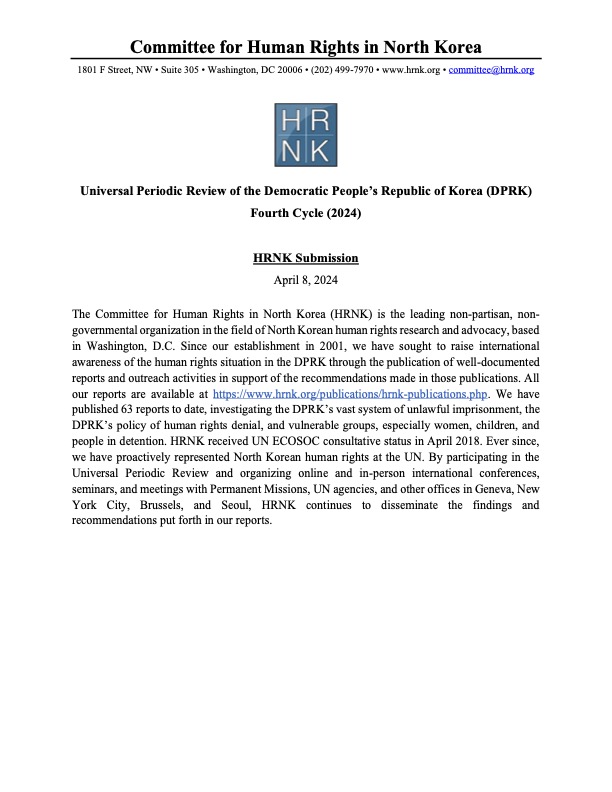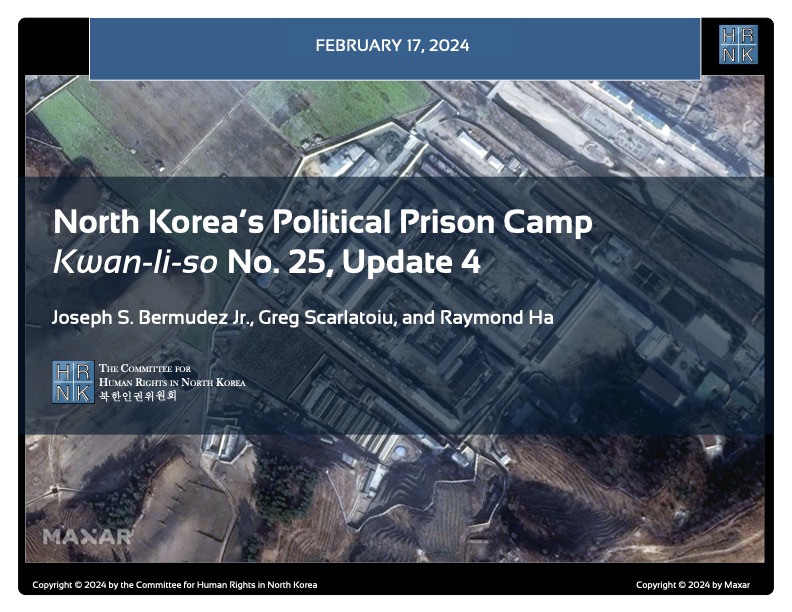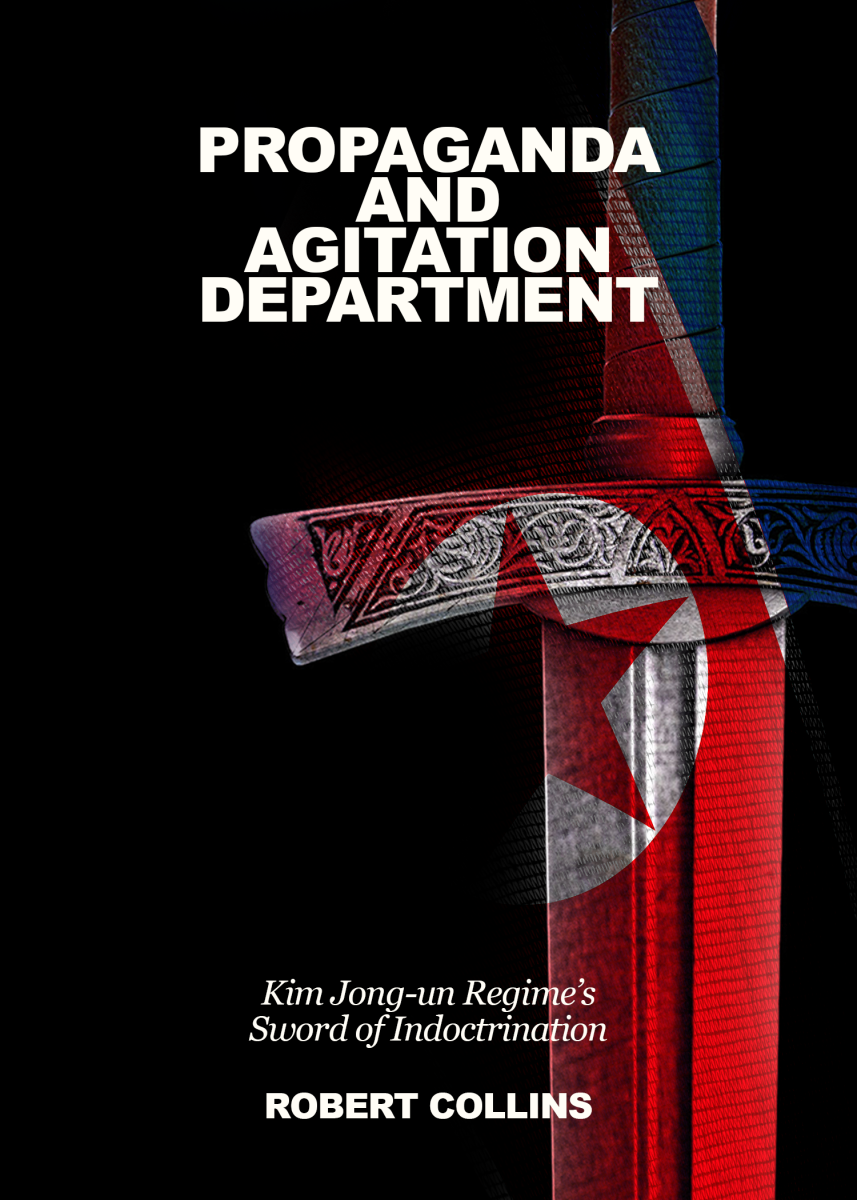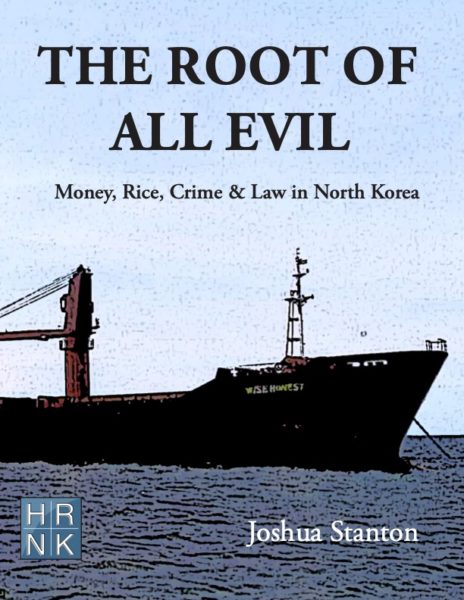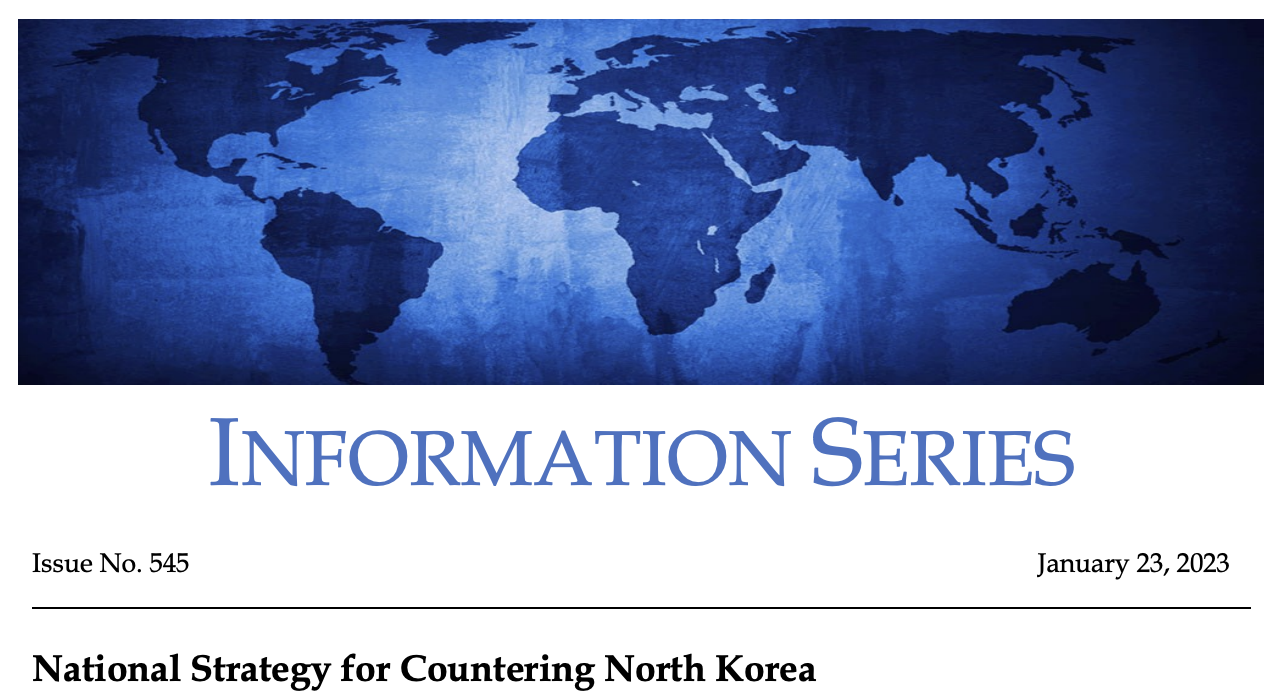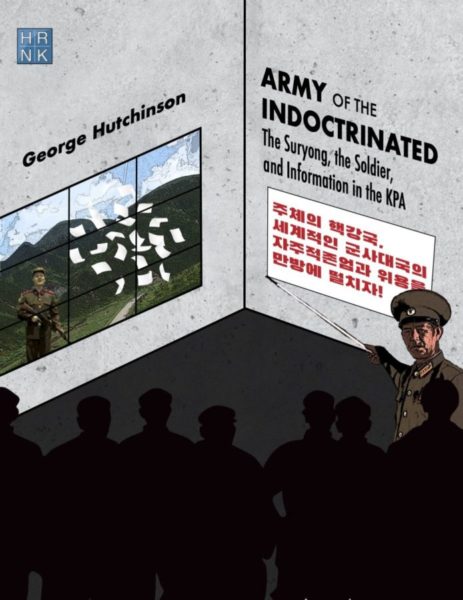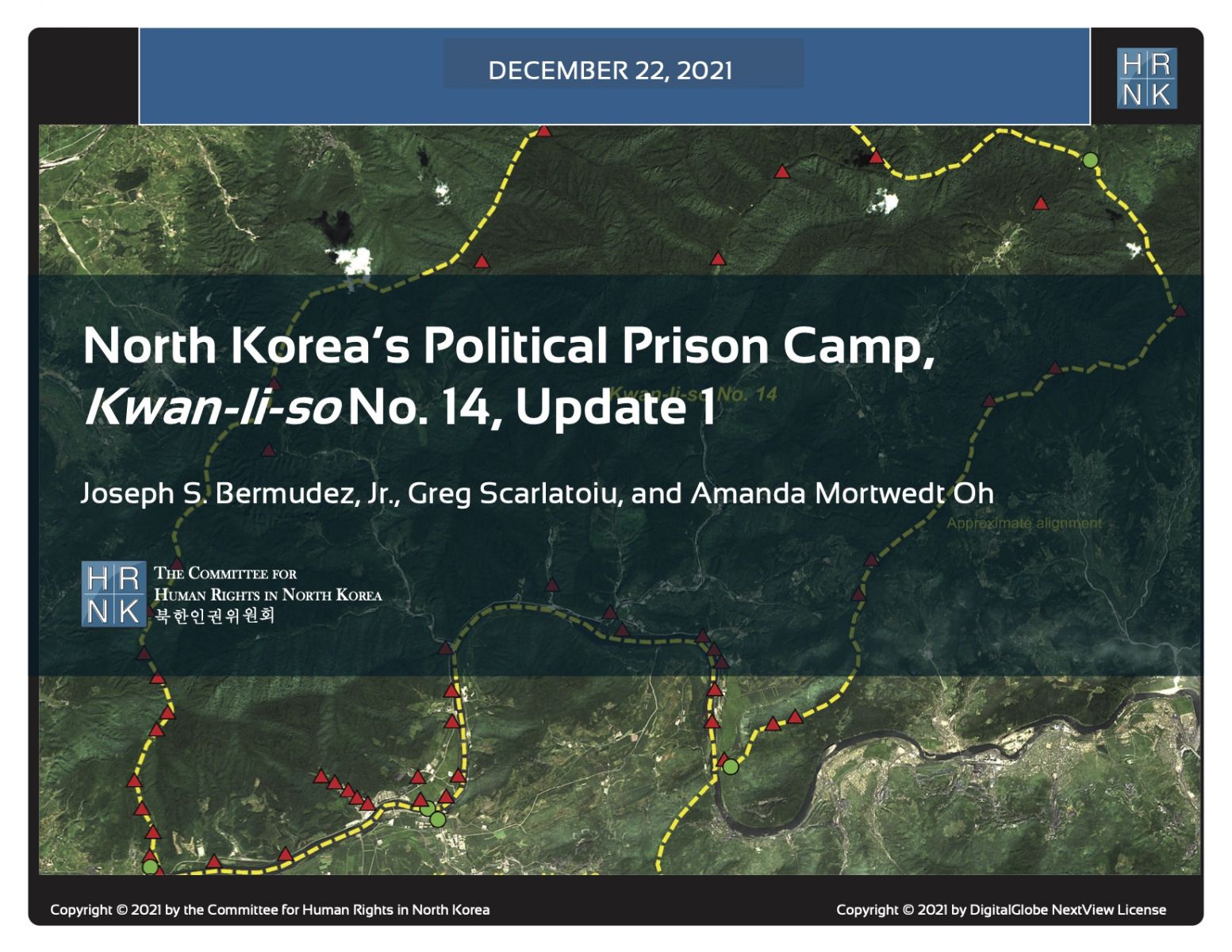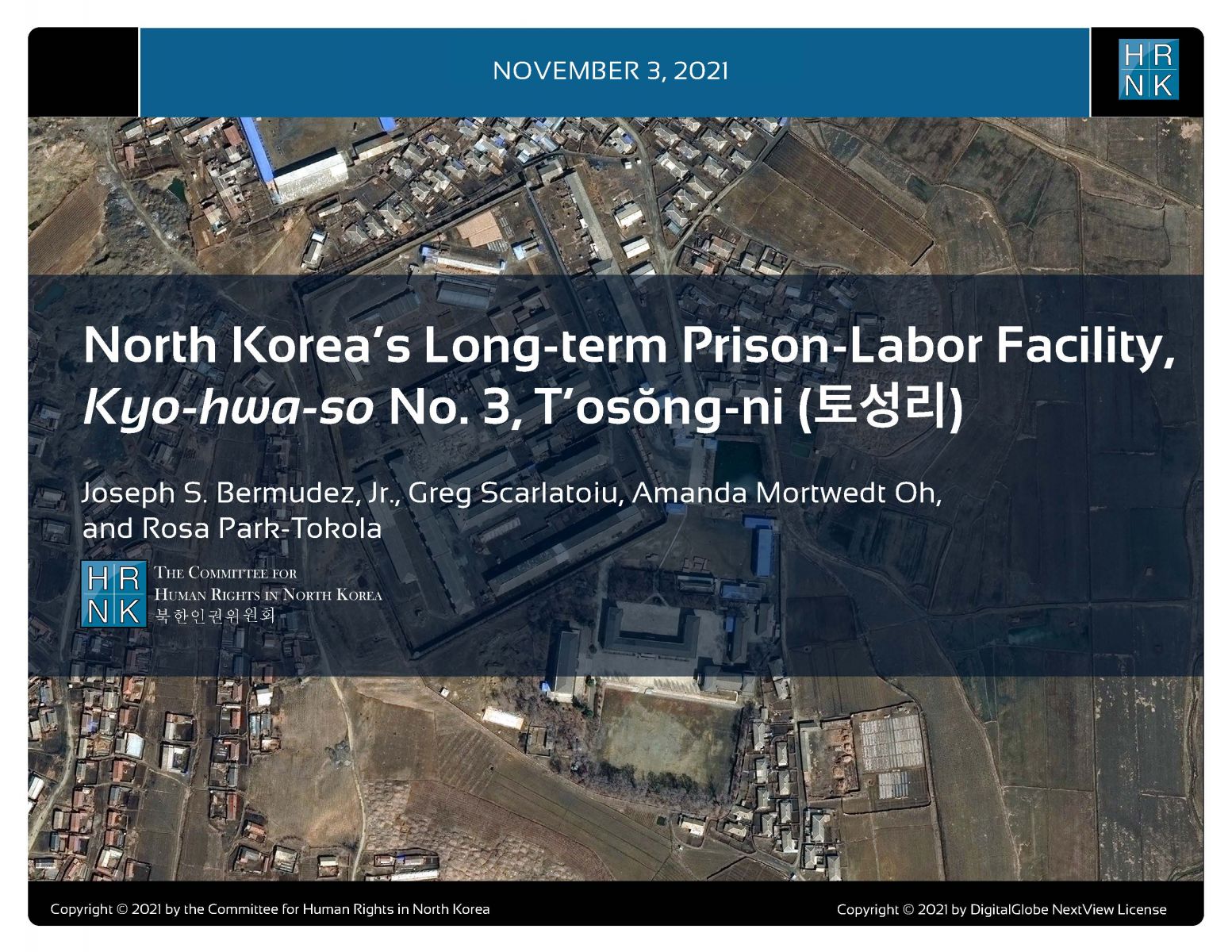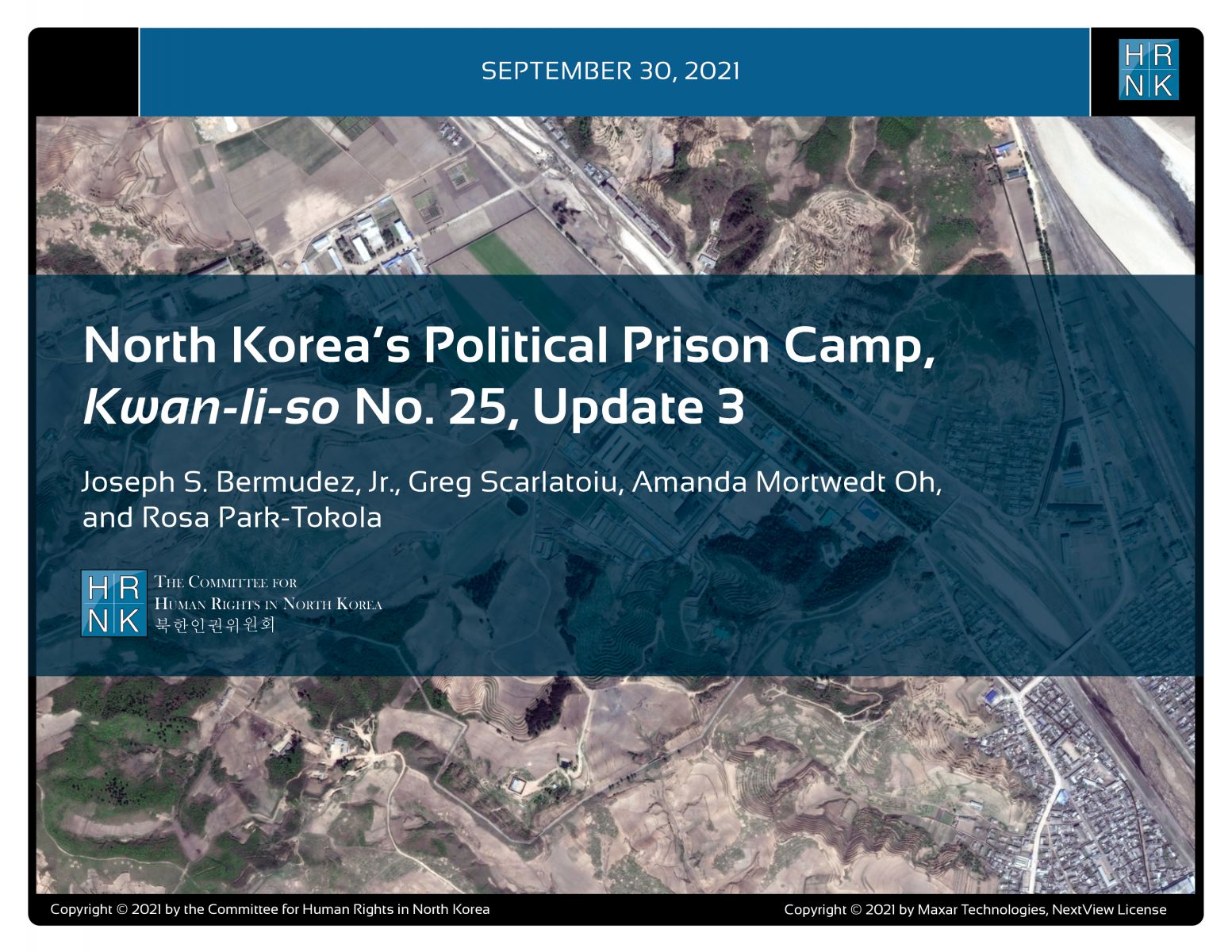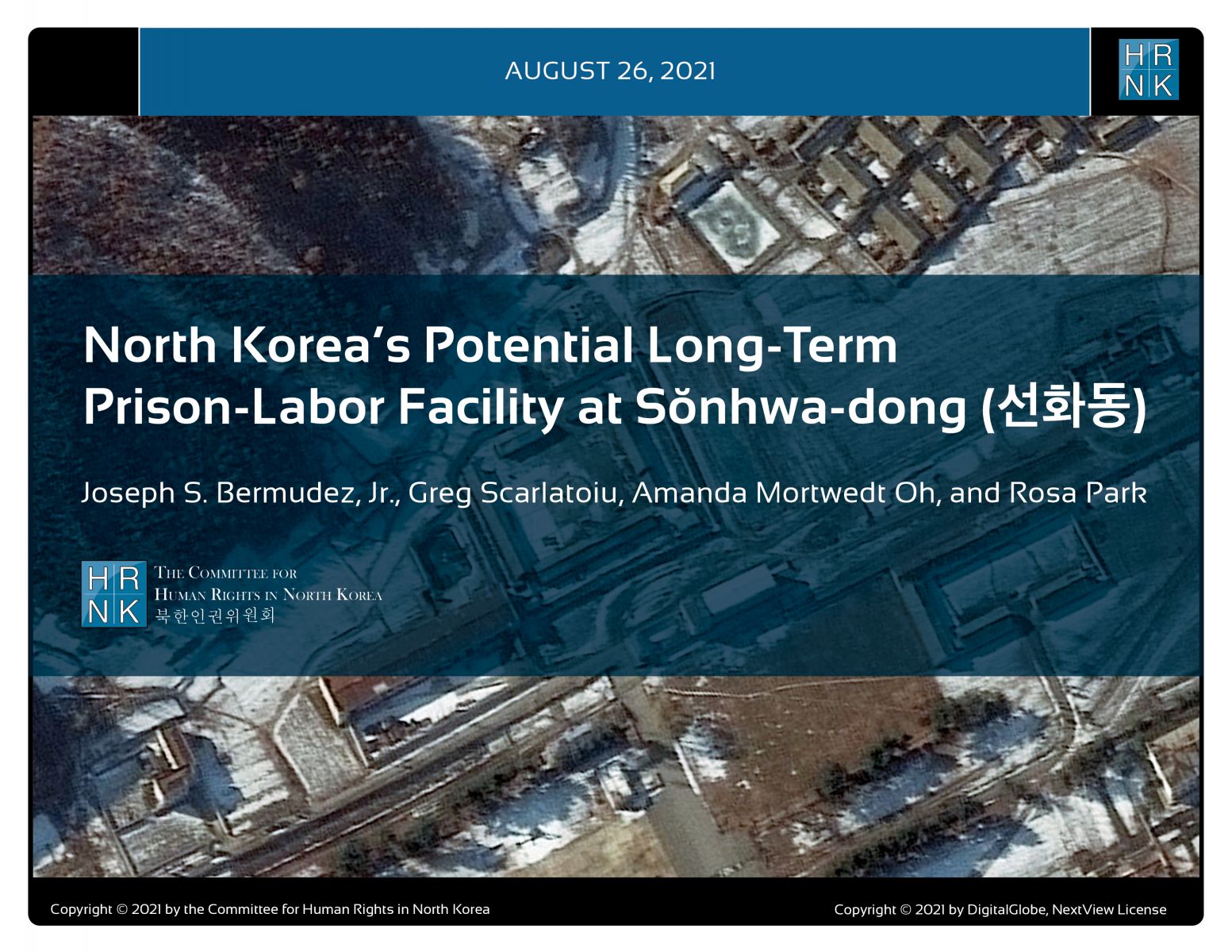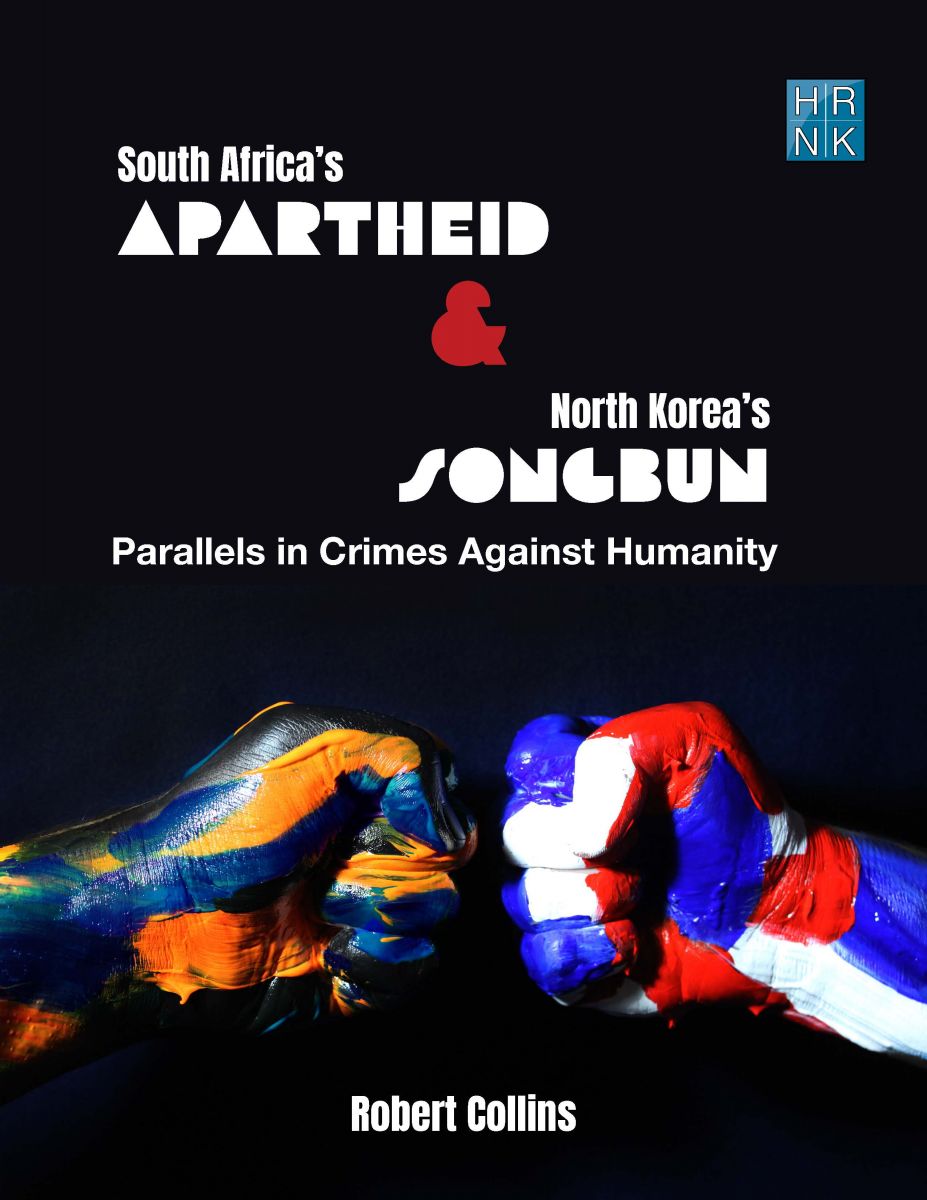BASED ON SATELLITE IMAGERY ANALYSIS, UPDATE HRNK REPORT HIGHLIGHTS CHANGES AT CAMP 25, 2016-2021. PRISON POPULATION CONSTANT, NO HIGHER THAN 5,000. THE EMPLOYMENT OF PRISON LABOR IN AGRICULTURE, LIVESTOCK, WOOD PRODUCTS AND LIGHT INDUSTRY CONTINUES. INTERNAL HIGH SECURITY PERIMETERS, LIKELY DETENTION FACILITIES FOR HIGH-VALUE DETAINEES, RECENTLY CONSTRUCTED. CHAIN OF COMMAND BELOW AND ABOVE COLONEL GENERAL JONG GYONG-TAEK, MINISTER OF STATE SECURITY, RESPONSIBLE FOR CRIMES AGAINST HUMANITY.
WASHINGTON, September 30, 2021. The Committee for Human Rights in North Korea (HRNK) releases today an update on the Susŏng-dong Political Prison Camp No. 25 in North Korea. This report is part of a comprehensive long-term project undertaken by HRNK to use satellite imagery and former detainee interviews to shed light on human suffering in the Democratic People’s Republic of Korea (DPRK, more commonly known as North Korea) by monitoring activity at political prison facilities throughout the nation. This report provides an abbreviated update to our three previous reports on a long-term political prison commonly identified by former prisoners and researchers as Kwan-li-so No. 25 by providing details of significant activity observed during 2016–2021. For this report HRNK analyzed 6 high-resolution commercial pan-sharpened multispectral and panchromatic satellite images of Kwan-li-so No. 25, and its immediate environs. Based on the satellite imagery analysis, Kwan-li-so No. 25 remains a fully operational prison established around 1968. This detention facility is well maintained by North Korean standards, as indicated by activity and general good maintenance inside the prison and in the adjacent areas.
Kwan-li-so No. 25 (41.834384, 129.725280) is located outside the town of Susŏng-dong (수성동, 41.827222, 129.736111), Ch’ŏngjin-si (청진, Ch’ŏngjin City, 41.887222, 129.831944), Hambuk (함북, North Hamgyŏng Province)—approximately 7.5 kilometers northwest of Ch’ŏngjin and 458 kilometers northeast of the capital city of P’yŏngyang. More specifically, it is located on the south bank of the Solgol-ch’ŏn (i.e., Solgol stream) across from the village of Susŏng-dong—to which one foot and two road bridges connect it. The prison consists of a moderately-sized walled compound, and headquarters, support, and guard housing areas.
This kwan-li-so is reported to be subordinate to the Prisons Bureau of the Ministry of State Security (MSS). The MSS itself reports to the State Affairs Commission chaired by (North) Korean Workers’ Party General Secretary Kim Jong-un. Since 2018, Colonel General Jong Gyong-taek has reportedly been the Minister of State Security. In December 2018, the U.S. Department of the Treasury included Colonel General Jong Gyong-taek in the “Specially Designated Nationals List Update” as a person of interest for illegal activities, including human rights violations. In March 2021, the European Union designated Colonel General Jong for human rights violations.
Author Joseph S. Bermudez, Jr. emphasized the importance of satellite imagery analysis in investigating the scale of crimes against humanity and other egregious human rights violations in North Korea: “The Kim regime commits crimes against humanity. There are at least 120,000 men, women, and children imprisoned in North Korea’s political prison camps. There is no need to exaggerate an already abysmal human rights situation. Satellite imagery analysis and pure geometry prove that the number of prisoners at Camp No. 25 could be no higher than 5,000. While efforts to scrutinize North Korea’s political prison camp system are commendable across the board, reports that the Camp No. 25 inmate population stands at 41,000 appear to be grossly exaggerated. That does not take away from the brutality of the Kim regime, a relentlessly unapologetic human rights denier.”
HRNK Executive Director Greg Scarlatoiu said: “HRNK’s satellite imagery project, masterly led and executed by author Joseph S. Bermudez, Jr. since 2012, proves that crimes against humanity continue to be perpetrated throughout North Korea’s vast system of unlawful imprisonment, up to the present. Inter-Korean dialogue, reconciliation, rapprochement, peace, and ultimately unification must stay at the top of the agenda. Such process must not ignore human rights. Rapprochement that ignores the human rights of over 20 million North Koreans, especially those 120,000 political prisoners and so many other victims of the Kim regime, is not genuine rapprochement. It is a mirage.”
HRNK Director of International Advocacy and Development Amanda Mortwedt Oh opined: “We must continue to monitor Camp 25 and its high-value detention area to bring attention to those political prisoners and their families who are unjustly targeted and disposed of—as if less than human—by the Kim regime.”
HRNK Director of Programs and Editor Rosa Park-Tokola pointed out: “With the third update of HRNK's coverage of Kwan-li-so No. 25 in Susŏng-dong, Ch’ŏngjin-si, Hambuk, we see continuous evidence of crimes against humanity that started around 1968. Now, with four reports on this location, including the original baseline assessment, this latest analysis directly tells the Kim regime that they will be held accountable for 53 years of brutalizing their own people.”
HRNK continues to call upon the Kim regime to acknowledge the existence of its political prison camps, to immediately improve the human security of prisoners, and to allow the International Committee of the Red Cross (ICRC) immediate, full, and genuine access to detention facilities in North Korea. It is imperative that the Kim regime comply with the Standard Minimum Rules for Treatment of Prisoners. Colonel General Jong Gyong-taek and the chain of command below and above him, all the way to the top leadership, are responsible for committing crimes against humanity throughout North Korea’s vast system of unlawful imprisonment and beyond.
For media inquiries, contact Greg Scarlatoiu at [email protected].
In this submission, HRNK focuses its attention on the following issues in the DPRK:
- The status of the system of detention facilities, where a multitude of human rights violations are ongoing.
- The post-COVID human security and human rights status of North Korean women, with particular attention to sexual and gender-based violence (SGBV).
- The issue of Japanese abductees and South Korean prisoners of war (POWs), abductees, and unjust detainees.
This report provides an abbreviated update to our previous reports on a long-term political prison commonly identified by former prisoners and researchers as Kwan-li-so No. 25 by providing details of activity observed during 2021–2023.
This report was originally published on Tearline at https://www.tearline.mil/public_page/prison-camp-25.
This report explains how the Kim regime organizes and implements its policy of human rights denial using the Propaganda and Agitation Department (PAD) to preserve and strengthen its monolithic system of control. The report also provides detailed background on the history of the PAD, as well as a human terrain map that details present and past PAD leadership.
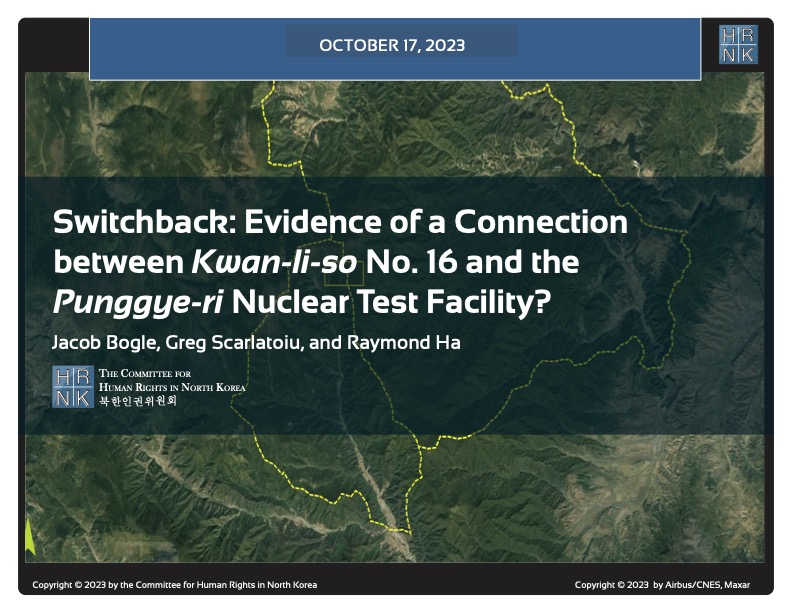
HRNK's latest satellite imagery report analyzes a 5.2 km-long switchback road, visible in commercial satellite imagery, that runs from Testing Tunnel No. 1 at North Korea's Punggye-ri nuclear test facility to the perimeter of Kwan-li-so (political prison camp) no. 16.
This report proposes a long-term, multilateral legal strategy, using existing United Nations resolutions and conventions, and U.S. statutes that are either codified or proposed in appended model legislation, to find, freeze, forfeit, and deposit the proceeds of the North Korean government's kleptocracy into international escrow. These funds would be available for limited, case-by-case disbursements to provide food and medical care for poor North Koreans, and--contingent upon Pyongyang's progress
For thirty years, U.S. North Korea policy have sacrificed human rights for the sake of addressing nuclear weapons. Both the North Korean nuclear and missile programs have thrived. Sidelining human rights to appease the North Korean regime is not the answer, but a fundamental flaw in U.S. policy.
(Published by the National Institute for Public Policy)
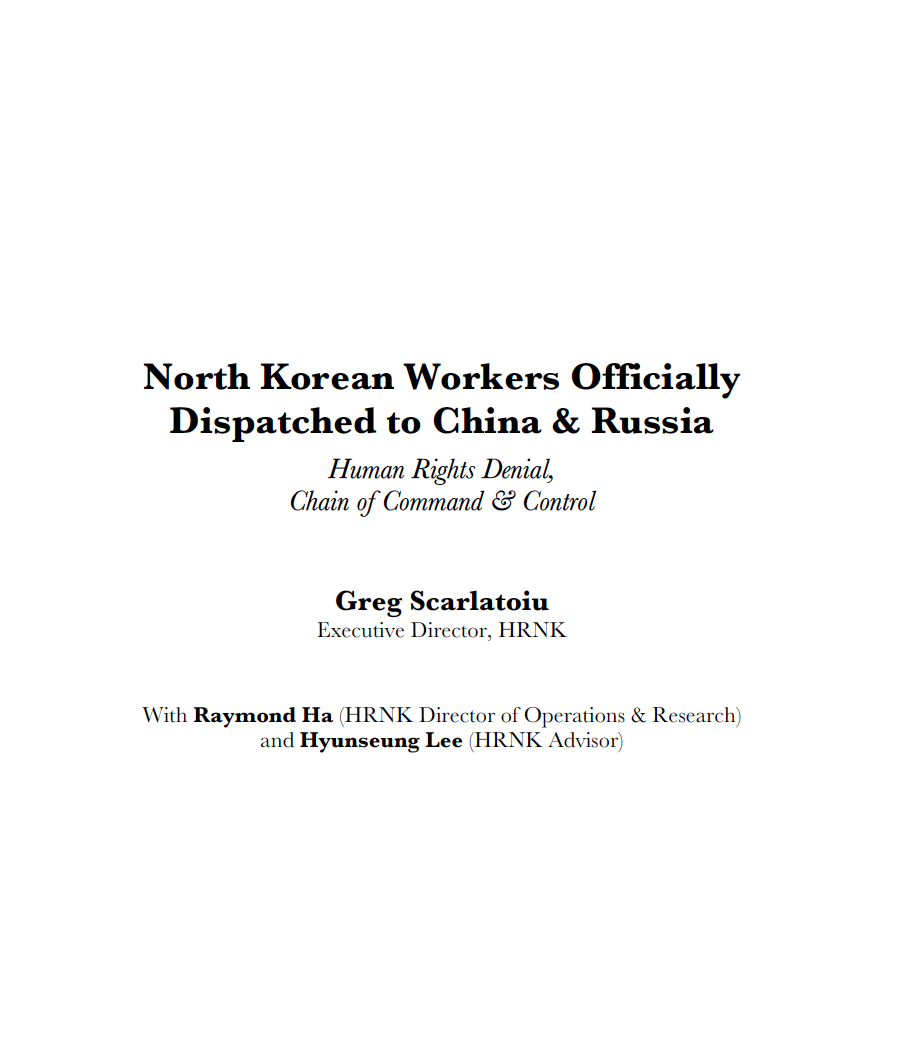
North Korea’s forced labor enterprise and its state sponsorship of human trafficking certainly continued until the onset of the COVID pandemic. HRNK has endeavored to determine if North Korean entities responsible for exporting workers to China and Russia continued their activities under COVID as well.
George Hutchinson's The Suryong, the Soldier, and Information in the KPA is the second of three building blocks of a multi-year HRNK project to examine North Korea's information environment. Hutchinson's thoroughly researched and sourced report addresses the circulation of information within the Korean People's Army (KPA). Understanding how KPA soldiers receive their information is needed to prepare information campaigns while taking into account all possible contingenc
This report is part of a comprehensive long-term project undertaken by HRNK to use satellite imagery and former prisoner interviews to shed light on human suffering in North Korea by monitoring activity at political prison facilities throughout the nation. This is the second HRNK satellite imagery report detailing activity observed during 2015 to 2021 at a prison facility commonly identified by former prisoners and researchers as “Kwan-li-so No. 14 Kaech’ŏn” (39.646810, 126.117058) and
This report is part of a comprehensive long-term project undertaken by HRNK to use satellite imagery and former prisoner interviews to shed light on human suffering in North Korea by monitoring activity at civil and political prison facilities throughout the nation. This study details activity observed during 1968–1977 and 2002–2021 at a prison facility commonly identified by former prisoners and researchers as "Kyo-hwa-so No. 3, T'osŏng-ni" and endeavors to e
This report is part of a comprehensive long-term project undertaken by HRNK to use satellite imagery and former detainee interviews to shed light on human suffering in the Democratic People’s Republic of Korea (DPRK, more commonly known as North Korea) by monitoring activity at political prison facilities throughout the nation. This report provides an abbreviated update to our previous reports on a long-term political prison commonly identified by former prisoners and researchers as Kwan-li-so<
Through satellite imagery analysis and witness testimony, HRNK has identified a previously unknown potential kyo-hwa-so long-term prison-labor facility at Sŏnhwa-dong (선화동) P’ihyŏn-gun, P’yŏngan-bukto, North Korea. While this facility appears to be operational and well maintained, further imagery analysis and witness testimony collection will be necessary in order to irrefutably confirm that Sŏnhwa-dong is a kyo-hwa-so.
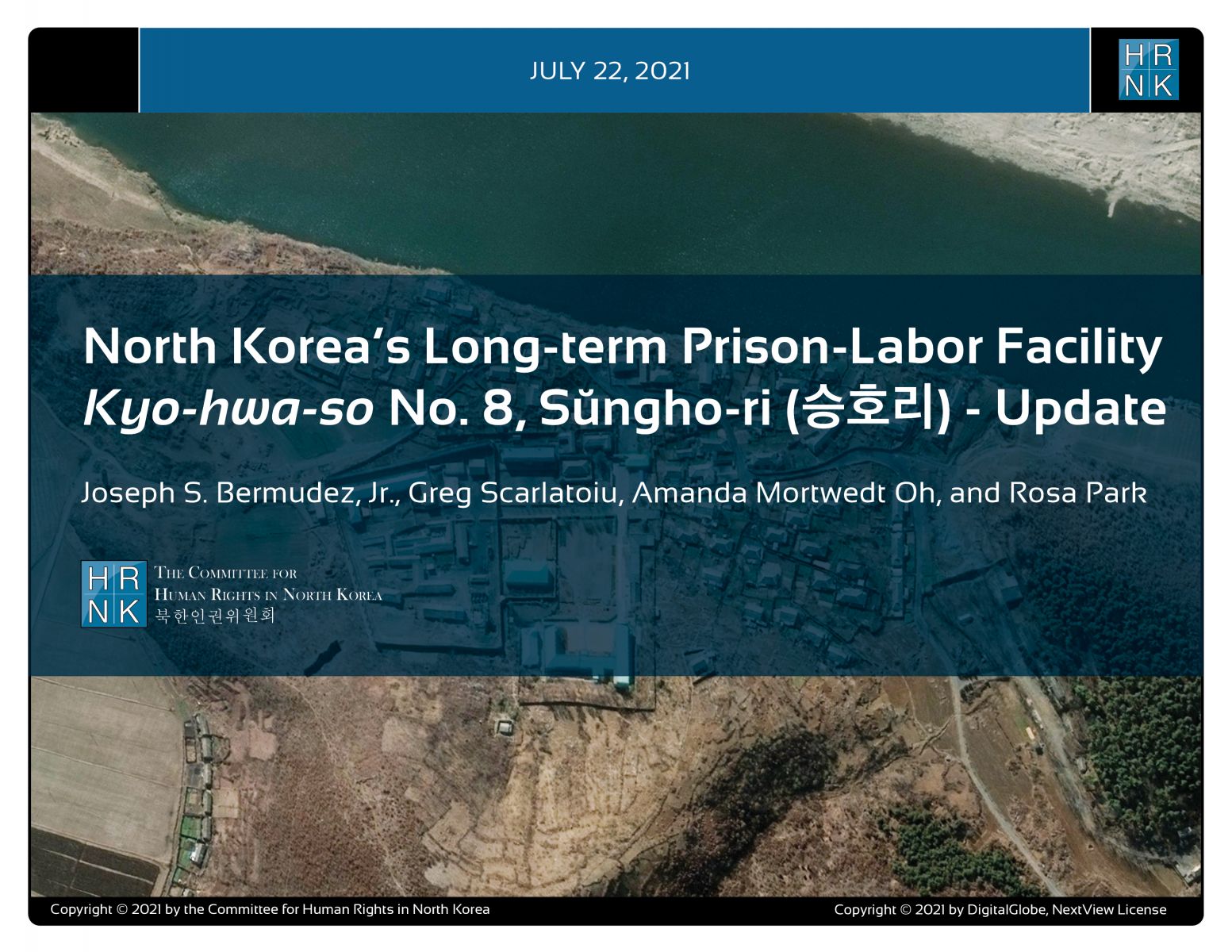
"North Korea’s Long-term Prison-Labor Facility Kyo-hwa-so No. 8, Sŭngho-ri (승호리) - Update" is the latest report under a long-term project employing satellite imagery analysis and former political prisoner testimony to shed light on human suffering in North Korea's prison camps.
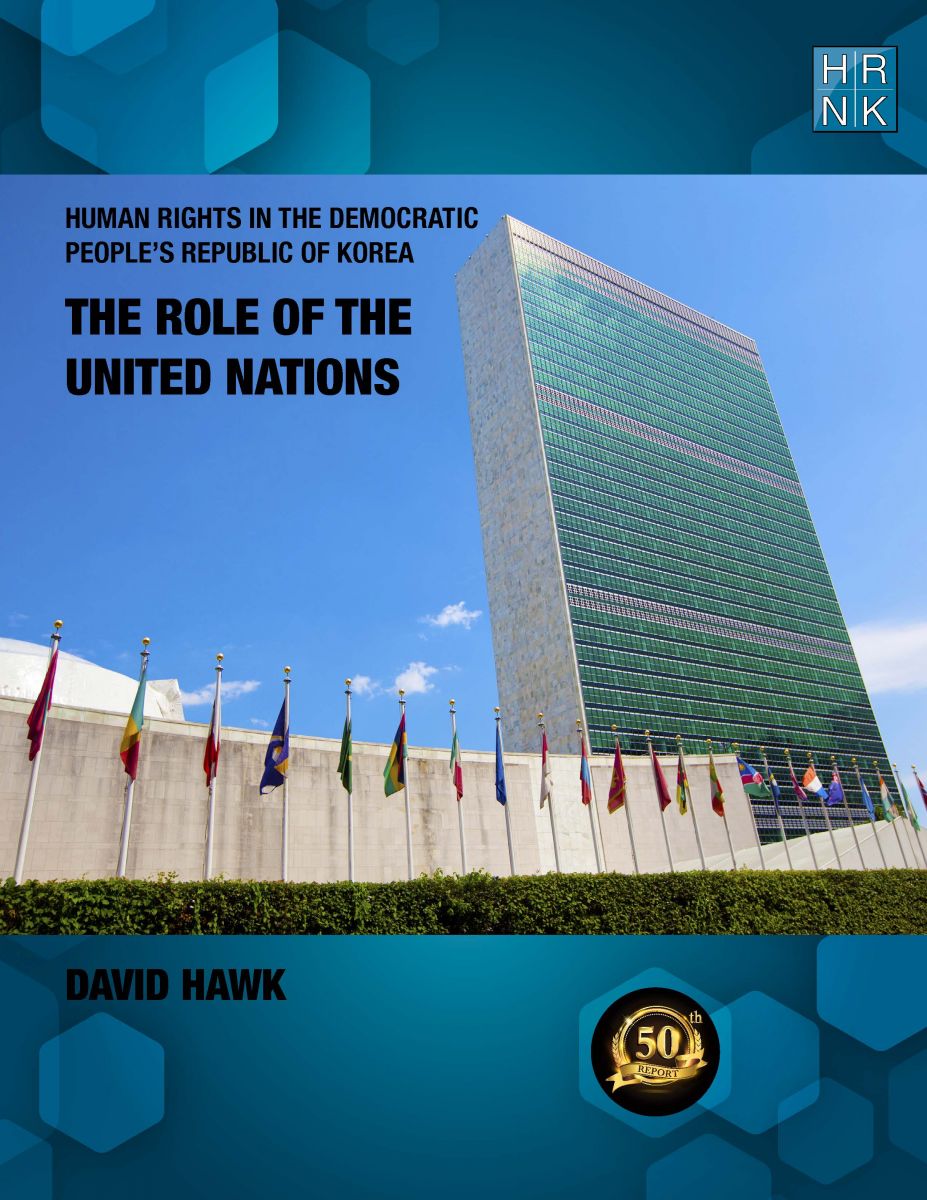
Human Rights in the Democratic Republic of Korea: The Role of the United Nations" is HRNK's 50th report in our 20-year history. This is even more meaningful as David Hawk's "Hidden Gulag" (2003) was the first report published by HRNK. In his latest report, Hawk details efforts by many UN member states and by the UN’s committees, projects and procedures to promote and protect human rights in the DPRK. The report highlights North Korea’s shifts in its approach
South Africa’s Apartheid and North Korea’s Songbun: Parallels in Crimes against Humanity by Robert Collins underlines similarities between two systematically, deliberately, and thoroughly discriminatory repressive systems. This project began with expert testimony Collins submitted as part of a joint investigation and documentation project scrutinizing human rights violations committed at North Korea’s short-term detention facilities, conducted by the Committee for Human Rights
